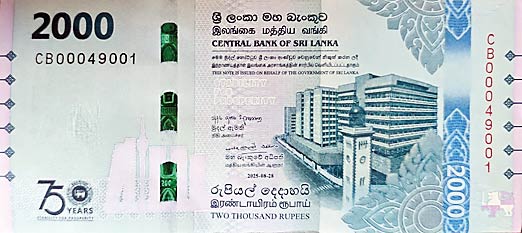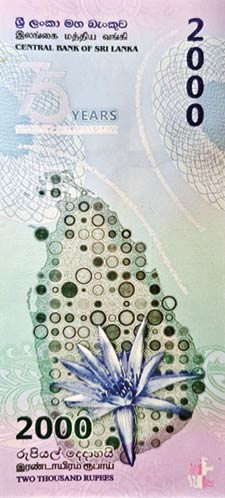Sri Lanka’s New Rs.2000 Note: Stability for Prosperity
On August 29 the Central Bank of Sri Lanka (CB) marked its 75th anniversary with the release of a commemorative Rs 2000 note. At first glance, the blue, green, and purple design is striking, and the inclusion of landmarks and motifs seems celebratory. Yet, a closer look reveals several unusual features, departures from tradition, and subtle signals worth reflecting on.
This Rs. 2000 issue also debuts the signature of Sri Lanka’s President, Anura Kumara Dissanayake, in his capacity as Minister of Finance. Their bilingual titles appear in Tamil in addition to Sinhala. Perhaps the most significant innovation is the wording of the legality clause. Since 1951, Lankan banknotes carried a long declaration of validity, initially only in English and since 1956 only in Sinhala. The legality statement has been shortened to just say This Note is issued on behalf of the Government of Sri Lanka, excluding and is legal tender in Sri Lanka for the payment of any amount , to enable it to be stated in all three languages, fulfilling an agreement with Sri Lanka Human Rights Commission in 2012. The Sinhala and Tamil word Banknote is better than Note, when the use as currencyis excluded. This is a first since the Dutch Kredit Brief that had the legality in Dutch, Sinhala, and Tamil.

New currency note
 For the first time, the note’s prefix and number are printed as a single, continuous sequence. “CB” followed by eight digits. It is a small but notable design decision that signals an attempt at modernisation and uniformity in currency numbering.
For the first time, the note’s prefix and number are printed as a single, continuous sequence. “CB” followed by eight digits. It is a small but notable design decision that signals an attempt at modernisation and uniformity in currency numbering.
The Central Bank only announced the note’s release after its ceremonial presentation to the President at the Presidential Secretariat. Earlier this year, I filed an RTI request to learn whether such a commemorative note was planned. The reply was dismissive: disclosure, it said, would “cause serious prejudice to the economy” by revealing future monetary decisions.
Perhaps the more controversial aspect of the design is the Colombo skyline depicted on the front. Alongside the Lotus Tower stands the Altair, Trizen, Cinamon Life, and ITC luxury apartment blocks — a montage of selected private, commercial projects that cater to a wealthy elite. Including them on the national currency blurs the line between public symbol and private promotion. Even more jarring is the silhouette of the Lotus Tower itself, closely associated with the SLPP government, defeated for mishandling of the economy. Its appearance on a note commemorating CBSL’s anniversary feels, at best, ironic.
Another departure from precedent: unlike all previous commemorative notes, CB did not issue a special folder for this Rs. 2000 release. Collectors accustomed to official presentation packs will moan the absence. Curiously, a CB folder was printed the very same week for the Postal Department’s first-day cover of their commemorative personalised stamp.
On the reverse, is a mosaic of 169 dots, arranged in a 21 by 12 rectangular grid to fill the outline of the island. Their purpose is obscure and defies easy interpretation. Are they a modernist flourish, a security feature, or an allegory yet to be explained?
The Rs. 2000 note embodies both progress and paradox. On the one hand, it represents a long-overdue embrace of trilingual inclusivity, a symbolic shift toward equality. On the other hand, its design choices — unexplained dots, luxury apartments, and Nelum Kuluna — raise questions about symbolism and appropriateness.
Fifty million notes have been printed, worth Rs. 100 billion – approximately 10 per cent of the current currency in circulation. However, given Sri Lanka’s commitments under the IMF programme not to expand money supply recklessly, these notes are unlikely to appear en masse. Instead, they will probably filter into the economy slowly, replacing damaged notes withdrawn from circulation. At a time when Sri Lanka’s economy is still fragile, the note’s restrained circulation reflects IMF oversight and fiscal caution. Yet, the muted publicity and reluctance to share information in advance suggest that transparency remains elusive.
Ultimately, this commemorative note is more than a collector’s item. It is a mirror of Sri Lanka today — celebrating progress, grappling with politics, and carrying hidden meanings in its design. As with all currency, its true value lies not only in rupees, but in the stories it tells about the nation it represents.
Hitad.lk has you covered with quality used or brand new cars for sale that are budget friendly yet reliable! Now is the time to sell your old ride for something more attractive to today's modern automotive market demands. Browse through our selection of affordable options now on Hitad.lk before deciding on what will work best for you!


